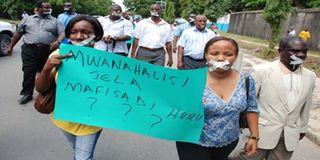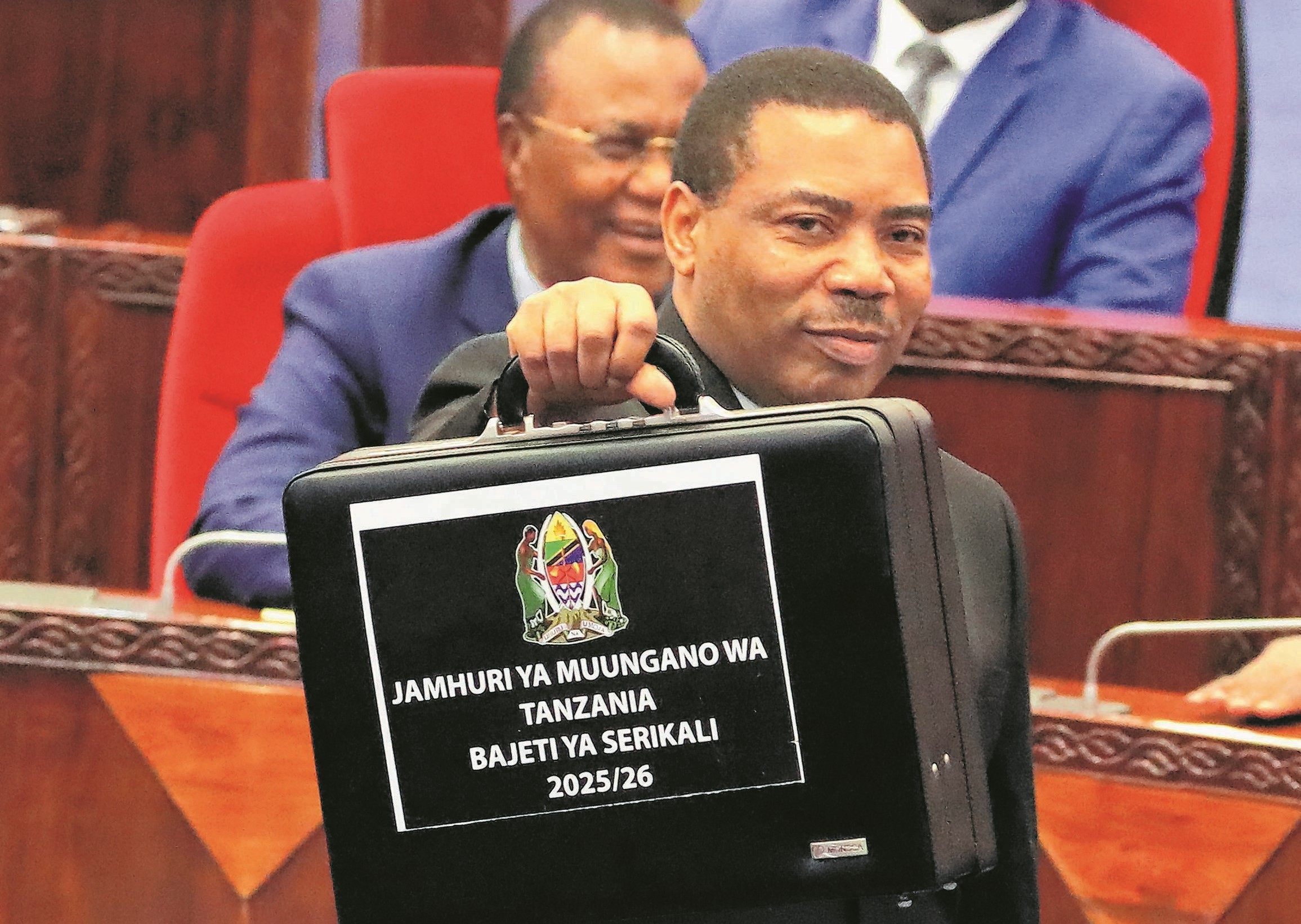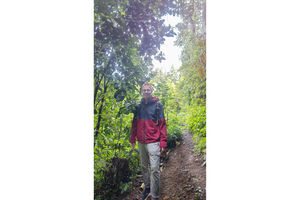How Dar nosedives in freedom of the press amid stalled reforms

Editors and other media stakeholders take to the streets to protest against the ban of a weekly tabloid, MwanaHalisi, which was banned indefinitely by the government over publishing seditious stories. PHOTO | FILE
What you need to know:
- The country was ranked in the 70th position last year from the 34th it occupied in 2012. At that position however, Tanzania is considered to be slightly better in the press freedom in the East Africa region, as Kenya comes at 71th, Uganda (104), Burundi (132) and Rwanda in the 161st position - the lowest in the region, according to the CPJ report.
Dar es Salaam. The perception that press freedom in Tanzania is diminishing was confirmed last week when the Committee to Protect Journalists (CPJ) announced that the country had dropped by 36 positions in the Press Freedom Index in a period of just one year.
The country was ranked in the 70th position last year from the 34th it occupied in 2012. At that position however, Tanzania is considered to be slightly better in the press freedom in the East Africa region, as Kenya comes at 71th, Uganda (104), Burundi (132) and Rwanda in the 161st position - the lowest in the region, according to the CPJ report.
A total of 179 countries were monitored worldwide with Finland ranked the best. Eritrea was ranked in the last position in press freedom.
In Africa, Namibia leads in the CPJ ranking, followed by Ghana, Burkina Faso and Niger.
The low ranking of Tanzania in the index is arguably due to a number of events last year that indicated that there were efforts to “muzzle” the media, with the government using a draconian law to suspend a number of media outlets for allegedly preaching hate.
It was last year when the government increased its crackdown, imposing a ban on two daily newspapers for publishing what it claimed to be “seditious stories”.
Moreover, it was last year when the government attempted to gag the media with a law that would have seen journalists face five years in prison or a fine of up to Sh5 million for publishing stories it considers as hate speech, inciting or peace disrupting information.
During the year, the world also continued to hear about deadly attacks on a number of journalists leaving them on the brink of death.
CPJ reports that police in Tanzania are believed to be the perpetrators of nearly a third of the cases involving attacks on journalists.
The attack on chairman of the Tanzania Editors’ Forum (TEF) and managing editor of New Habari (2006) Corporation, Mr Absalom Kibanda (47), in March last year, sent shock waves not only locally, but also all over the world, signalling that journalists were not safe anymore.
Mr Kibanda was seriously injured after unknown number of people attacked him outside his house when he was returning from office.
During the incident, some of the senior editor’s teeth were pulled out, fingernails plucked out, and his left eye pierced. He spent three months undergoing specialised treatment in a South African hospital.
Then, a team formed to investigate the attack concluded that Mr Kibanda’s attack was engineered by security officials in a plot to spur political animosities between the main opposition party, Chadema and another major political party.
The attack happened a day before he could appear in the Kisutu Resident Magistrate’s Court to face charges of sedition along with two other people.
The case stems from a feature article that appeared in a Kiswahili daily tabloid, Tanzania Daima, for which he was the managing editor, before he joined New Habari.
The charges were dropped last month after prosecution failed to prove beyond reasonable doubt that Mr Kibanda and other accused were guilty. The other two accused in the case were former Mwananchi Communications Limited (MCL) Group managing editor Theophil Makunga and writer Samson Mwigamba.
In October, the government continued its crackdown with a ban on two newspapers for publishing what it called seditious stories.
Through the Tanzania Information Services Department, the government banned Mwananchi and Mtanzania allegedly for publishing stories allegedly meant to turn the masses against their government. The two papers were suspended for 14 and 90 days respectively.
The government claimed in its announcement that the two media outlets’ kind of journalism was threatening the country’s existing peace and tranquility.
The ban attracted fierce criticism from different people in Tanzania with most of them accusing the government of using a draconian law that has been criticised by media practitioners over the years.
Media and human rights defenders in the country feel that the situation in the country has been caused by laws governing the operation of the “Fourth Arm” of the State.
The executive secretary of the Media Council of Tanzania, (MCT), Mr Kajubi Mukajanga, says that 2013 would go down as the darkest year in the history of the country. He says that the situation wasn’t helped by the fact that the minister responsible for the media was herself keen on ensuring the media is gagged.
“The government was trying to make the law even worse,” he told this reporter recently. According to Mr Mukajanga, the killing of a journalist in Iringa, the attack on the chairman of the Editors Forum and the banning of two media outlets was a sign that press freedom was under attack.
Executive director of the Tanzania Human Rights Defenders Coalition (THRDC), Mr Onesmo Olengurumwa, says that as the country heads towards the General Election, we are likely to see more of the efforts to silence the media.
“We also have to understand that there is a state of impunity…people commit atrocities on journalists, but you don’t hear actions being taken. Where are Mr Kibanda’s attackers?” Mr Olengurumwa asks.
He says as the country is now in the process of writing the new Constitution, there should be in the Supreme Law clauses that explicitly guarantee the freedom of the media and that those who dare to violate the provisions are met with the full force of the law.
However, as CPJ reports, for five years, Tanzanian authorities have pledged to address the issue of legislation, but no changes has taken place lately. According to CPJ, existing laws on media have always been used to induce self-censorship in the independent press.
Worldwide, however, CPJ reports that digital surveillance, the unchecked murder of journalists, and indirect commercial and political pressures on the media are three of the primary threats to press freedom.
“The primary battlegrounds for press freedom used to be contained within the borders of authoritarian states. While those battles continue, new technologies have made it possible to realise the right to freedom of expression, regardless of frontiers,” says CPJ executive director Joel Simon in the report.
“Attacks on the press describe the threats and explores strategies to safeguard the free flow of information.”
In East Africa, CPJ reports that many newspapers are thriving, some fat with ads while enjoying solid circulation and little competition.
There is, however, a broad concern that all that advertising is also promoting self-censorship and corrupting news coverage.
Because they represent the greatest source of revenue, advertisers, especially governments and government-owned enterprises, wield huge influence, which often allows them to quietly control what is published and what is not, CPJ says.
Advertisers offer lucrative ads to sweeten any coverage or threaten to stop them, if the paper writes critically about them.
One novel news suppression technique adopted in Tanzania is a blanket advertising strategy that involves placing full-page ads that leave no room for anything else on the front and back pages, according to John Mireny, publications and research manager of the Media Council of Tanzania, which is the country’s independent regulator.
Commercial pressures on reporters and editors are not confined to the recruiting and retaining advertisers. As in many Western newsrooms, there is an increasing focus on cost-cutting and profits, even ad spending is on the rise in places such as Kenya.
According to the Newspaper Association of America, newspaper advertising revenue fell by six per cent in 2012 and is expected to decline further as newspapers increasingly rely on revenue from circulation. This is not so in Kenya.
In the first quarter of 2012, 18 billion Kenyan shillings (roughly $212 million) was spent on advertising, according to the research company Ipsos Synovate, while 12 billion Kenyan shillings (roughly $141 million) was spent in the same period in 2011.
Across the region, governments still wield powerful influence, despite increasing numbers of private companies buying ad space. Even then, Kenyan companies that advertise heavily are often financially linked to the government, said media consultant Gatchie.
The Kenyan government is the largest shareholder, for instance, at Kenya Commercial Bank, and the Kenyan subsidiaries of Standard Chartered and Barclays Bank.
It is also one of the largest shareholders of Safaricom, the country’s leading telecommunications company. Then there is direct advertising by the government.
According to the chairman of the Kenyan Commission for Administrative Justice, Otiende Amollo, the government spent roughly 26 million Kenyan Shillings ($297,500) in just two weeks on congratulatory messages in newspapers to politicians in presidential and legislative elections held in March last year.
In Rwanda, approximately 85 to 90 per cent of advertisements come from the public sector, says Robert Mugabe, editor of the online news site Great Lakes Voice.
“If you need to attract adverts, it’s simple. Don’t annoy government,” he said.
Government money constitutes roughly 60 per cent of the advertising revenue of newspapers in Tanzania. This crucial revenue is often provided to publications that support the government, Mireny says, to the disadvantage of independent publications.
The survival instincts of the dominant political elite in East Africa, where opposition parties maintain marginal influence, ensure government advertisers apply pressure on the press.
In Kenya, as elsewhere, the ruling party maintains near monopolistic control over ads in the media, says William Oloo Janak, chairman of the Kenya Correspondent’s Association.
Government advertising is so pervasive that some publications are launched purely to milk the flow of money.
Globally, the US government’s mass surveillance programmes and its capacity to store transactional data and the content of communications, according to the report, undermine journalists’ ability to protect sources.
The scope of the National Security Agency (NSA)’s digital spying raises doubts about the US commitment to freedom of expression and strengthens the hand of China and other restrictive nations in their calls for more government control over the Internet.



